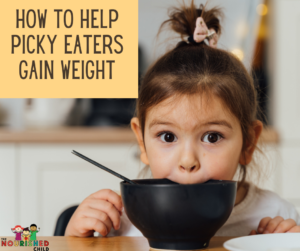7 Principles of Serving Healthy Toddler Meals
October 30, 2019
Choosing healthy toddler meals is a crucial step to nourishing your child well and raising a healthy eater. But, it’s not just about healthy meals and healthy foods.
Learn what to focus on so you can ensure your toddler is eating nutritious meals, growing well, and developing healthy habits for the future.
Healthy toddler meals aren’t easy to pull off. Because feeding toddlers can be a tough job.
I know. I’ve done it myself with my own four kids and I hear it from the parents with which I work.
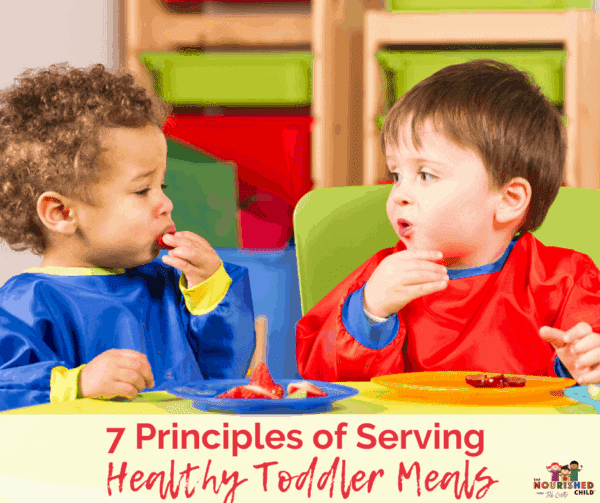
The Goals of a Toddler Nutrition Plan
As a pediatric nutritionist, I think a game plan for feeding your toddler is such a helpful thing. From meal plans to your approach to feeding and interacting around food, your overarching strategy can make feeding your toddler easier.
The main goals for feeding during toddlerhood are:
- Aim for balanced toddler meals so all nutrients needs are met
- Support normal growth and development
- Foster self-feeding, independence and autonomy
- Expand the palate through new foods, textures and flavors
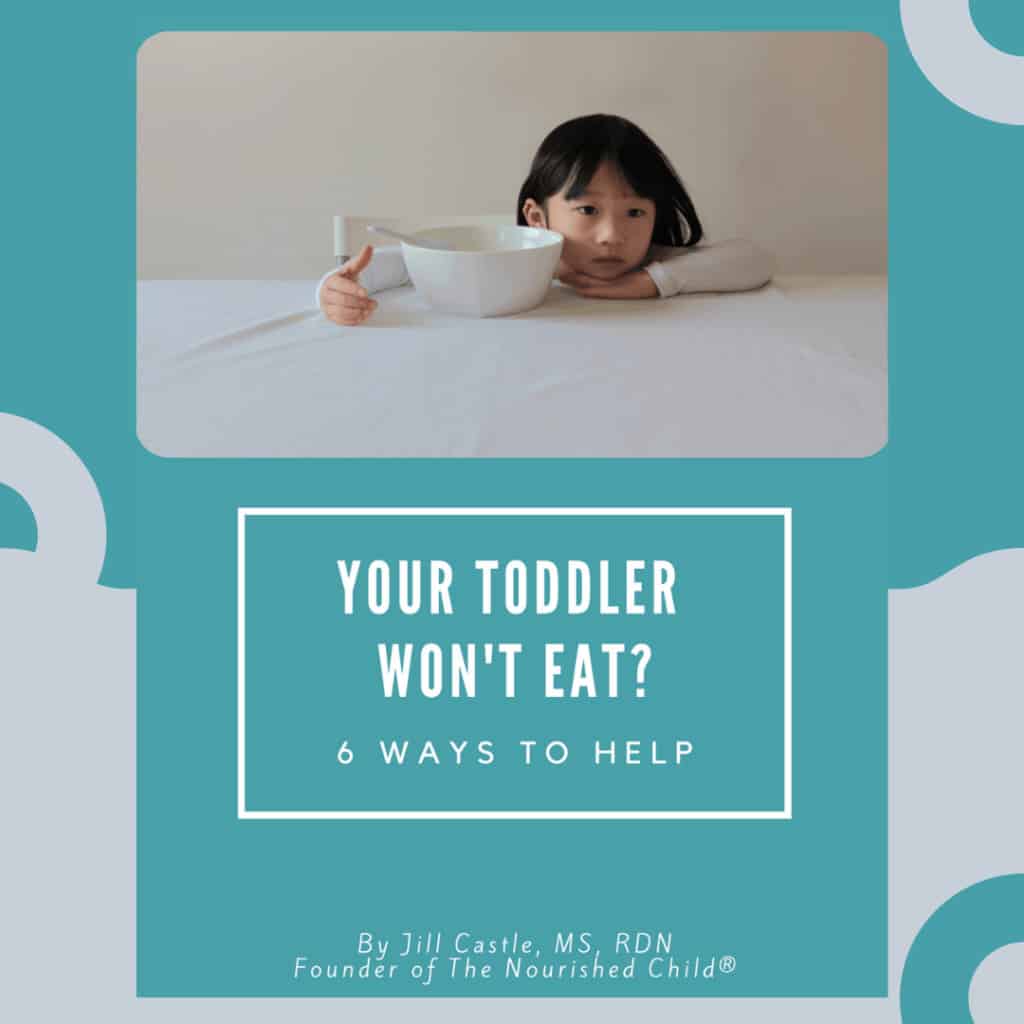
Get your guide to help your toddler eat:
7 Core Principles of Nutritious Toddler Meals
To meet these goals, you need to have your plan in place. Here are the 7 core principles you need to have in mind as you develop and work on your plan for feeding your toddler well.
- Strive to Offer Balanced Meals
- Give Most of the Food Groups at Mealtime
- Encourage Trying New Foods Regularly
- Watch Important Nutrients for the Toddler
- Encourage Independent Eating (Self-Feeding)
- Use a Toddler Meal Plan
- Offer Toddler Food Portions
Let’s dive a little deeper!
1. Offer balanced meals
The definition of a balanced meal for a toddler isn’t different from that of an older child.
It includes the five main food groups and offers the key nutrients your toddler needs to grow well.
- Protein foods
- Whole grains
- Fruit
- Vegetables
- Dairy or Non-Dairy, Fortified Substitute
Ideally, at each meal you’ll want to offer a food from each food group.
2. Offer most of the food groups at mealtimes
The good news? The food groups are an easy way to cover the key nutrients for brain, bone and body growth, plus all the other ones (which are still important).
Here are examples of a meal plan for the toddler highlighting the food groups:
Toddler Meal Plan for Breakfast
- Scrambled eggs
- Whole grain toast with butter
- Sliced strawberries
- Plain yogurt
It can be hard to squeeze in vegetables at breakfast time for any child. Try scrambling eggs with spinach. Or, pop some spinach or kale into a fruit smoothie.
If you can’t get vegetables to fit into breakfast, don’t worry about it. You have other meals and snacks where you can work them in.
Toddler Meal Plan for Lunch
- Turkey deli meat
- Whole grain crackers
- Thin slivers of red pepper
- Hummus for dipping
- Applesauce
- Milk
Lunch is one of the easiest meals to offer toddlers!
Use leftovers from dinner the night before or choose simple, nutritious foods such as the meal plan above.
Toddler Meal Plan for Dinner
Feed your toddler what you are eating yourself!
There is no need to make something different for your toddler. When you do make something unique, you start to fall into the short-order cook habit.
You’ll be better off in the long run if you feed your toddler the same meal you are eating.
- Salmon
- Brown rice
- Broccoli with cheese sauce
- Blueberries
- Milk
Can I give my toddler sweets and treats?
The recommendation is to hold off on offering sweets to children under the age of two. There are several reasons for this:
- Toddlers have tiny tummies and high nutrient needs, necessitating a nutrient rich diet.
- Flavor preference development is in high gear at this age. Eating sweets helps young children develop a liking of them. Spend more attention on offering bitter, sour and umami flavors, as these food preferences need to be learned.
- Of course, birthday cake and other special occasions can still happen! Make sweets at these occasions the exception, not the norm.
3. Encourage your toddler to try new foods regularly
One key goal during toddlerhood is to introduce new foods.
This can be hard because many toddlers will start to get finicky with food and eating.
You must persevere despite this.
The only way children become healthy eaters who like lots of different foods is through repeated exposure to new foods.
This takes time, but it does work, especially if you don’t put too much pressure to eat on your child.
[Read: Don’t Force Kids to Eat]
For example, a 2016 study offered disliked vegetables eight different times before kids warmed up to them and accepted them. Even as time went on, the kids still showed acceptance of the veggies they tried in the study.
The message here? Don’t give up simply because your child rejected a vegetable you offered once or twice. It can take several offerings!
[Did you know I have a workbook to help parents of picky eaters? It’s called Try New Food: How to Help Picky Eaters Taste, Eat & Like New Foods]
Toddlers become healthy eaters who like lots of different foods through repeated exposure to new foods. #feedingtoddlers #trynewfoods #pickyeaters Click To Tweet4. Highlight the important nutrients for toddlers
In toddlerhood, there are over 40 nutrients required for normal growth and development.
The brain, body and bones are forming and developing during this stage of childhood. Nutrients are key elements to this process.
- Brain – Focus on iron, zinc, choline and omega-3 fatty acids like DHA.
- Bones – Calcium and vitamin D help build hard, strong bones.
- Body – Adequate calories, protein and fat are important for normal weight gain and height growth.
In my book, Fearless Feeding, my co-author and I outline the 5 key nutrients to pay attention to for toddlers.
Of course, your toddler needs more than 5 nutrients, but by paying attention to these five, there’s a good chance you’ll hit all 40.
[Learn more about providing your toddler with the nutrients he needs from my e-book, Nutrients for Kids, Advanced Guide.]
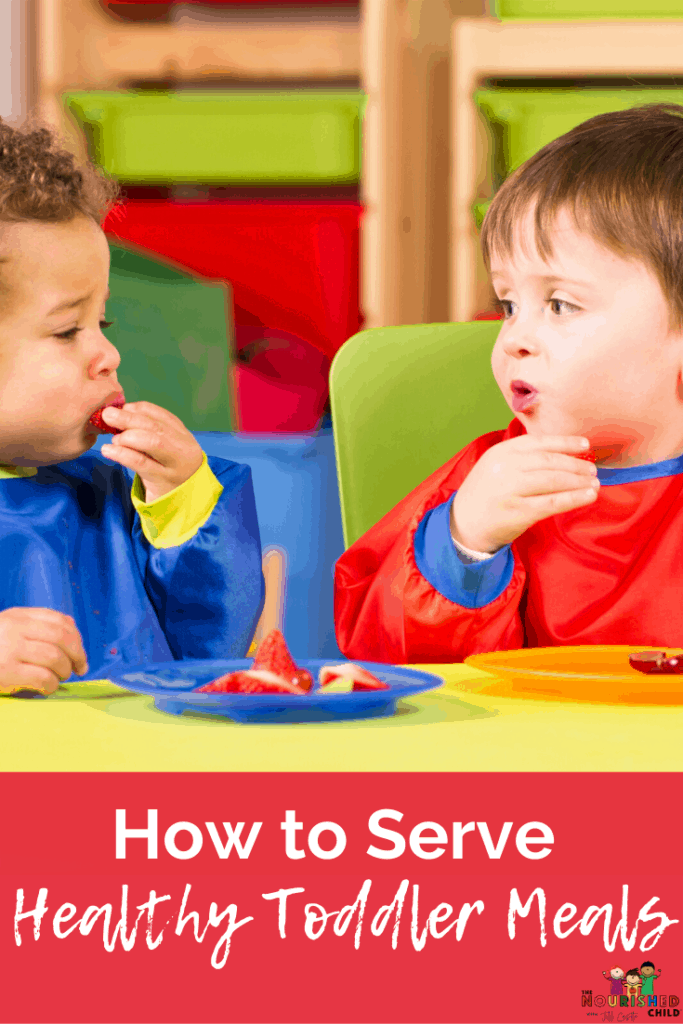
5. Encourage independent eating (Self-feeding)
One of the big goals for early childhood is for toddlers to develop self-feeding skills.
That means letting your child feed himself, create mess, and pace his eating.
In order to do this, you need to stop spoon feeding or placing food in your toddler’s mouth, hover less, and not interrupt your child while he’s eating.
(I know you have good intentions here, but it’s a big distraction for your toddler.)
Also, let your toddler get messy.
Food on the face, hands, arms and chest builds tolerance to smells, textures and sensation.
For toddlers who may have a more sensitive sensory system, getting messy (and not wiping/cleaning them) helps them learn to tolerate food and the eating process better.
Food on the face, hands, arms and chest builds tolerance to smells, textures and sensation. #feedingtoddlers #pickyeaters Click To Tweet6. Plan your toddler meal plan in advance
Don’t wing it. I see so many parents doing this and it leads to too much repetition with foods.
The balance of food can get off, too.
Young kids may get bored of eating the same foods over and over. This can lead to worsening of picky eating.
Take the time to plan out what you’re giving your toddler to eat.
Map out at least a 24 hour plan, or a few days at a time. It will help you hit the food groups, the nutrients and the variety of foods that are good for your little one.
7. Start with toddler food portions
Studies show that parents tend to overfeed toddlers. That is, they give them too much food.
I think this is human nature, but it does potentially turn off and/or overwhelm your toddler. And if it doesn’t overwhelm, it may teach him to overeat.
So let’s get those toddler portions right from the start. Then, be responsive with feeding and pay attention to whether your child is still hungry and wants more.
Appetite will vary based on where your child is with growth, so be keen to your child’s appetite and offer more food if indicated.
Healthy Toddler Meals are Key to Healthy Eating
Follow these 7 principles and you’ll be well on your way to raising a toddler who enjoys eating, grows well, and gets all the nutrition he needs!
Need more help with feeding toddlers?
Check out our booklets, workshops and free tutorials on feeding kids.
Also, check out the following articles:
Positive Talk with Toddlers about Food
27 Breakfast Ideas for Toddlers
How to Really Raise a Healthy Eater
Deconstructed Food: Win Kids Over
What principles do you want to work on?


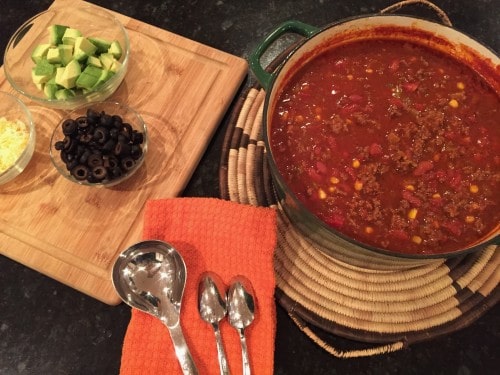
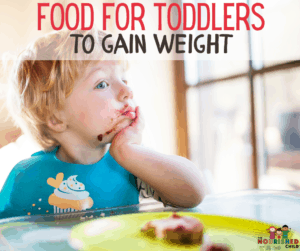
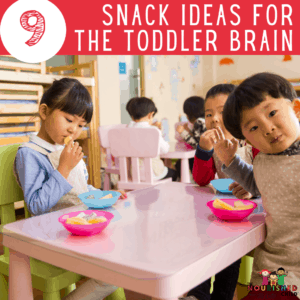

![My Toddler Won’t Eat! [Step-by-Step Guide]](https://thenourishedchild.com/wp-content/uploads/2021/04/Your-Toddler-Wont-Eat-optin-graphic-300x300.jpg)
